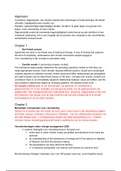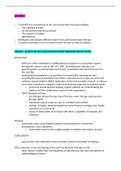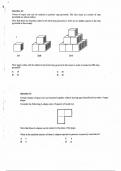Algemeen:
Contradics: tegenspraak. een situatie waarbij twee beweringen of waarnemingen die elkaar
uitsluiten, tegelijkertijd waar moeten zijn.
Paradox: ogenschijnlijke tegenstrijdige situatie, die lijkt in te gaan tegen ons gevoel voor
logica, onze verwachting of onze intuïtie.
Ogenschijnlijk omdat de vermeende tegenstrijdigheid veelal berust op een denkfout of een
verkeerde redenering. het is ook mogelijk dat de paradox een uitspraak is die verschillende
semantische niveaus bevat.
Chapter 1
- Non-lineair proces
Apparently we need a non-lineair way of looking at change. A way of looking that captures
the kind of complexity, ambivalence and circular movements people engage in.
Voor verandering is tijd, energie en perceptie nodig.
- Cynefin model (= perceiving complex context)
The framework helps leaders determine the prevailing operative context so that they can
make appropriate choices. Each domain requires different actions. simple and complicated
contexts assume an ordered universe, where cause-and-effect relationships are perceptible,
and right answers can be determined based on the facts. Complex and chaotic contexts are
unordered- there is no immediately apparent relationship between cause and effect, and the
way forward is determined based on emerging patterns. the ordered world is the …
De simpele context gaat uit van het herhalen van patronen en consistentie in
gebeurtenissen. Er is een duidelijke oorzaak-gevolg relatie voor de gebeurtenissen die
plaatsvinden. Het managementproces vindt plaats door; zingeving, categorisatie en dan pas
een antwoord. Een gevaar voor dit type context is dat het risico bestaat dat er te simpel
wordt gedacht en dit zich blijft voordoen.
Chapter 2
Menselijke voorwaarden voor verandering
Hierbij kun je denken aan het model van Kurt Lewin. Deze houdt in dat verandering volgens
drie fasen verloopt. Unfreeze-> Movement-> Refreeze. Van het unfreezen(het losweken van
de oude situatie) naar -> moving(nieuwe situatie met reële perspectieven) tot -> freezen
(mensen nieuwe handelingsperspectief bieden/ stabilisering van de nieuwe situatie).
Veranderstrategie onder change management (CM)
- (+ waarom belangrijk voor veranderproces)= het gaat over :
1. action plan in which certain routes are plotted and decisions to be made are
planned.
2. an understanding of the dimensions of change and of the options or degrees
of freedom that limit the decision-making.
3. the assumptions we have about the territory.
- (+ in hoeverre aanspreken van internal commitment en hoeverre niet)
Machts-dwang strategie= klassieke vorm van CM (power-coercive): (most feasible result)
,= Verandering wordt bewerkstelligd door middel van politieke of economische sancties. Zij
gaan ervan uit dat mensen veranderen omdat:
1. we are convinced in general that power is legitimate and carries right with it (i.e.
we should listen to those who hold power)
2. we believe that power-substitutes such as having more knowledge, seniority,
earning more money etc or being part of a dominant coalition, are also
legitimate and carry rights with them.
3. we are prone to punishment when we do not follow the directions of those who
outrank us.
→ McGregor Theory X: mensen zijn bang en lui en moeten gemotiveerd worden.
Empirisch-rationele strategie (empirical-rational assumptions) (best solution possible):
= wanneer men geconfronteerd wordt met informatie waaruit blijkt dat verandering in eigen
belang is zullen mensen verandering accepteren. Mensen veranderen omdat:
1. we are rational and driven primarily by self-interest, on the condition that the
right info that interests us is put forward in an engaging and convincing manner.
2. we are especially susceptive when this info is gathered by experts, who try to
ensure us that the info is accurate and gained by professional methodological
protocols.
3. we are in need of clarity and structure, and as such are influenced by a well
argumented, structured change design with clearly specified results, which are
laid down beforehand.
4. we are result driven, decisive, accurate and dedicated to what we planned.
Normative- re-educatieve strategy (means allowing and supporting people to take ownership
of their own learning processes) = most consensus.
= Verandering wordt alleen teweeggebracht wanneer individuen een mate van
ontevredenheid ervaart met de sociale status quo. Mensen veranderen omdat:
1. we are susceptible to the feeling or idea of ownership of the things we develop,
which can be stimulated by actively involving organisation members in working
out programmes of change under their own direction.
2. we are susceptible to changes in our social situation, identify, membership, the
relationships we have with colleagues and executives, so that when these
change, our perception and behaviour change accordingly.
3. we are loyal to relevant others, the department or the organisation.
4. we are convinced that change suits our social needs and self-fulfillment, and
gives us opportunities to learn and develop ourselves, resulting in a boost of
our commitment and motivation.
Verklaring onderliggende paradox (internal-external commitment) van Argyris
Argyris dichotomie
Model 1 Advocacy Model 2 Inquiry
Unilateraal controle bij het realiseren van je verkrijgen van de meest valide informatie
, doelen (zenden en discussie beperken) beschikbaar.
focus op winnen, niet op verliezen uitgaan van gelijkwaardigheid en verken
achterliggende waarden
Benadruk rationaliteit benadruk internal commitment
Onderdruk negatieve gevoelens streef naar vrije en goed geïnformeerde
beslissingen
Argyris advocacy (model I) & inquiry (model II): Volgens Argyris kun je onderscheid maken
tussen managers/interventionisten/consultants die inquiry of advocacy. Advocacy (model I) =
mensen in model I doen aan: eenzijdige controle, single loop learning, gewoon doen, acties
obv rationaliteit & feiten Niet kijkend naar onderliggende structuren die problemen
veroorzaken. Model II (inquiry) = willen zoveel mogelijk informatie verzamelen voordat ze
een strategie bepalen. Gaan uit van gelijkheid en waarden en interne commitment. Zoekt
naar onderliggende oorzaken van problemen. Senge – reciprocal inquiry: wederzijds
onderzoek (?); heeft theorie over hoe je verandering teweeg kan brengen bij deze 2 types.
Hij heeft het voornamelijk over de juiste vragen stellen en reciprocal inquiry. Iedereen maakt
zijn/haar denken expliciet (benoemd denk stappen) en onderworpen aan openbaar keuring.
→ zie hc 8
Verband paradox internal-external commitment met double bind (onderdeel
paradoxical complex contexts)
Voorbeeld double bind: competing commitment
- wat valt op?
- herken je dit
- bespreek de werking ervan
Belang van definiëren van verandering in: inhoud, context en proces.
Context: waarom moeten we veranderen? In welke context moet de verandering
plaatsvinden. Context maakt namelijk duidelijk waarom verandering nodig is. Om deze
situatie te begrijpen moet je een current reality creëren obv verschillende sociale percepties.
Proces: hoe te veranderen? Dit betreft methodes, interventies en verandertypen. De
processen waarop verandering teweeg moet worden gebracht.
Content/inhoud: Wat moet er veranderen? Welke factoren in de organisatie moeten
veranderen.
Basis veranderstrategie “empirisch rationeel” met inhoud, context en proces.
1. we are rational and driven primarily by self-interest, on the condition that the right info
that interests us is put forward in an engaging and convincing manner.
2. we are especially susceptive when this info is gathered by experts, who try to ensure
us that the info is accurate and gained by professional methodological protocols.
3. we are in need of clarity and structure, and as such are influenced by a well
argumented, structured change design with clearly specified results, which are laid
down beforehand.
Contradics: tegenspraak. een situatie waarbij twee beweringen of waarnemingen die elkaar
uitsluiten, tegelijkertijd waar moeten zijn.
Paradox: ogenschijnlijke tegenstrijdige situatie, die lijkt in te gaan tegen ons gevoel voor
logica, onze verwachting of onze intuïtie.
Ogenschijnlijk omdat de vermeende tegenstrijdigheid veelal berust op een denkfout of een
verkeerde redenering. het is ook mogelijk dat de paradox een uitspraak is die verschillende
semantische niveaus bevat.
Chapter 1
- Non-lineair proces
Apparently we need a non-lineair way of looking at change. A way of looking that captures
the kind of complexity, ambivalence and circular movements people engage in.
Voor verandering is tijd, energie en perceptie nodig.
- Cynefin model (= perceiving complex context)
The framework helps leaders determine the prevailing operative context so that they can
make appropriate choices. Each domain requires different actions. simple and complicated
contexts assume an ordered universe, where cause-and-effect relationships are perceptible,
and right answers can be determined based on the facts. Complex and chaotic contexts are
unordered- there is no immediately apparent relationship between cause and effect, and the
way forward is determined based on emerging patterns. the ordered world is the …
De simpele context gaat uit van het herhalen van patronen en consistentie in
gebeurtenissen. Er is een duidelijke oorzaak-gevolg relatie voor de gebeurtenissen die
plaatsvinden. Het managementproces vindt plaats door; zingeving, categorisatie en dan pas
een antwoord. Een gevaar voor dit type context is dat het risico bestaat dat er te simpel
wordt gedacht en dit zich blijft voordoen.
Chapter 2
Menselijke voorwaarden voor verandering
Hierbij kun je denken aan het model van Kurt Lewin. Deze houdt in dat verandering volgens
drie fasen verloopt. Unfreeze-> Movement-> Refreeze. Van het unfreezen(het losweken van
de oude situatie) naar -> moving(nieuwe situatie met reële perspectieven) tot -> freezen
(mensen nieuwe handelingsperspectief bieden/ stabilisering van de nieuwe situatie).
Veranderstrategie onder change management (CM)
- (+ waarom belangrijk voor veranderproces)= het gaat over :
1. action plan in which certain routes are plotted and decisions to be made are
planned.
2. an understanding of the dimensions of change and of the options or degrees
of freedom that limit the decision-making.
3. the assumptions we have about the territory.
- (+ in hoeverre aanspreken van internal commitment en hoeverre niet)
Machts-dwang strategie= klassieke vorm van CM (power-coercive): (most feasible result)
,= Verandering wordt bewerkstelligd door middel van politieke of economische sancties. Zij
gaan ervan uit dat mensen veranderen omdat:
1. we are convinced in general that power is legitimate and carries right with it (i.e.
we should listen to those who hold power)
2. we believe that power-substitutes such as having more knowledge, seniority,
earning more money etc or being part of a dominant coalition, are also
legitimate and carry rights with them.
3. we are prone to punishment when we do not follow the directions of those who
outrank us.
→ McGregor Theory X: mensen zijn bang en lui en moeten gemotiveerd worden.
Empirisch-rationele strategie (empirical-rational assumptions) (best solution possible):
= wanneer men geconfronteerd wordt met informatie waaruit blijkt dat verandering in eigen
belang is zullen mensen verandering accepteren. Mensen veranderen omdat:
1. we are rational and driven primarily by self-interest, on the condition that the
right info that interests us is put forward in an engaging and convincing manner.
2. we are especially susceptive when this info is gathered by experts, who try to
ensure us that the info is accurate and gained by professional methodological
protocols.
3. we are in need of clarity and structure, and as such are influenced by a well
argumented, structured change design with clearly specified results, which are
laid down beforehand.
4. we are result driven, decisive, accurate and dedicated to what we planned.
Normative- re-educatieve strategy (means allowing and supporting people to take ownership
of their own learning processes) = most consensus.
= Verandering wordt alleen teweeggebracht wanneer individuen een mate van
ontevredenheid ervaart met de sociale status quo. Mensen veranderen omdat:
1. we are susceptible to the feeling or idea of ownership of the things we develop,
which can be stimulated by actively involving organisation members in working
out programmes of change under their own direction.
2. we are susceptible to changes in our social situation, identify, membership, the
relationships we have with colleagues and executives, so that when these
change, our perception and behaviour change accordingly.
3. we are loyal to relevant others, the department or the organisation.
4. we are convinced that change suits our social needs and self-fulfillment, and
gives us opportunities to learn and develop ourselves, resulting in a boost of
our commitment and motivation.
Verklaring onderliggende paradox (internal-external commitment) van Argyris
Argyris dichotomie
Model 1 Advocacy Model 2 Inquiry
Unilateraal controle bij het realiseren van je verkrijgen van de meest valide informatie
, doelen (zenden en discussie beperken) beschikbaar.
focus op winnen, niet op verliezen uitgaan van gelijkwaardigheid en verken
achterliggende waarden
Benadruk rationaliteit benadruk internal commitment
Onderdruk negatieve gevoelens streef naar vrije en goed geïnformeerde
beslissingen
Argyris advocacy (model I) & inquiry (model II): Volgens Argyris kun je onderscheid maken
tussen managers/interventionisten/consultants die inquiry of advocacy. Advocacy (model I) =
mensen in model I doen aan: eenzijdige controle, single loop learning, gewoon doen, acties
obv rationaliteit & feiten Niet kijkend naar onderliggende structuren die problemen
veroorzaken. Model II (inquiry) = willen zoveel mogelijk informatie verzamelen voordat ze
een strategie bepalen. Gaan uit van gelijkheid en waarden en interne commitment. Zoekt
naar onderliggende oorzaken van problemen. Senge – reciprocal inquiry: wederzijds
onderzoek (?); heeft theorie over hoe je verandering teweeg kan brengen bij deze 2 types.
Hij heeft het voornamelijk over de juiste vragen stellen en reciprocal inquiry. Iedereen maakt
zijn/haar denken expliciet (benoemd denk stappen) en onderworpen aan openbaar keuring.
→ zie hc 8
Verband paradox internal-external commitment met double bind (onderdeel
paradoxical complex contexts)
Voorbeeld double bind: competing commitment
- wat valt op?
- herken je dit
- bespreek de werking ervan
Belang van definiëren van verandering in: inhoud, context en proces.
Context: waarom moeten we veranderen? In welke context moet de verandering
plaatsvinden. Context maakt namelijk duidelijk waarom verandering nodig is. Om deze
situatie te begrijpen moet je een current reality creëren obv verschillende sociale percepties.
Proces: hoe te veranderen? Dit betreft methodes, interventies en verandertypen. De
processen waarop verandering teweeg moet worden gebracht.
Content/inhoud: Wat moet er veranderen? Welke factoren in de organisatie moeten
veranderen.
Basis veranderstrategie “empirisch rationeel” met inhoud, context en proces.
1. we are rational and driven primarily by self-interest, on the condition that the right info
that interests us is put forward in an engaging and convincing manner.
2. we are especially susceptive when this info is gathered by experts, who try to ensure
us that the info is accurate and gained by professional methodological protocols.
3. we are in need of clarity and structure, and as such are influenced by a well
argumented, structured change design with clearly specified results, which are laid
down beforehand.




